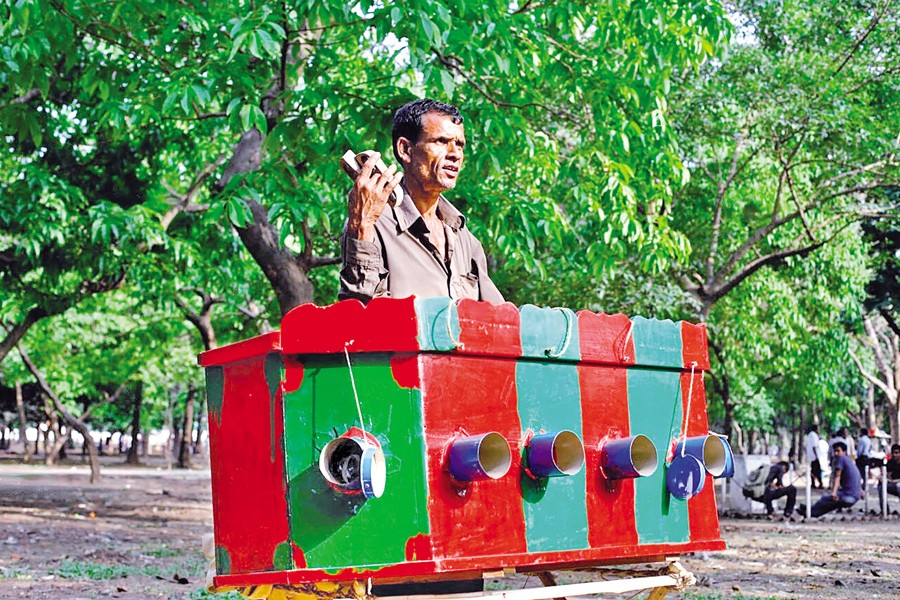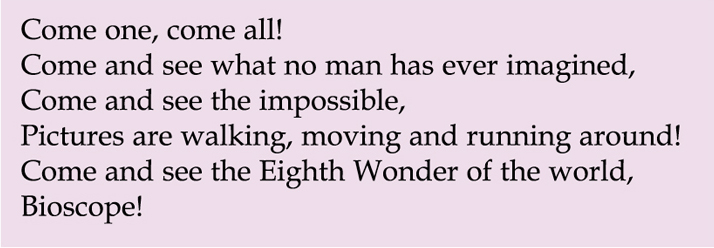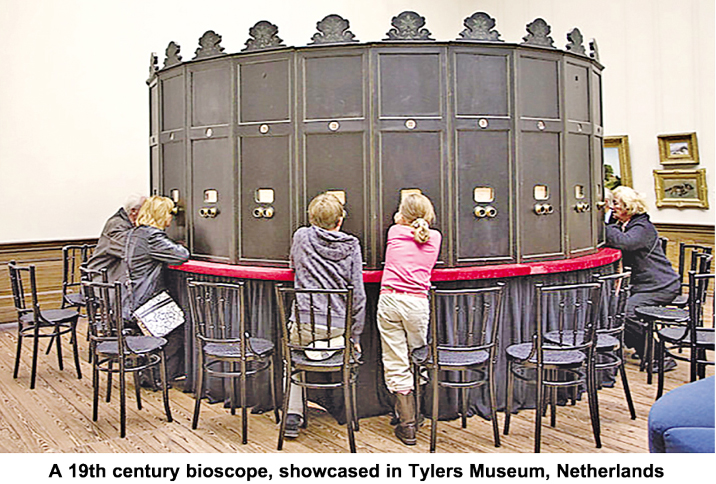
 The lines are from a poster advertising the first form of cinema or motion pictures in the world, written playfully in Bangla - an invitation to watch a bioscope show. A bioscope - a square or hexagon with little round holes inside which the magic happens.
The lines are from a poster advertising the first form of cinema or motion pictures in the world, written playfully in Bangla - an invitation to watch a bioscope show. A bioscope - a square or hexagon with little round holes inside which the magic happens.
Let a story be the wind that sails this ship amid the waves of nostalgia. A ten-year-old girl was once out with her father to what she can only remember to be the most colourful fair yet. With the splashes of colour and laughter everywhere, she could hardly keep her head straight. But what amazed her most was a red square box with six round holes cut through it. Children were peeking through the little holes with both their hands clutching the holes and then bursting out in laughter. An old man was spinning the handle, and light shades were coming out from the corners of the box.
The box had paintings of flowers and leaves, with kings and queens drawn beside them, little colourful paper flags dangling from the deck. The girl stepped towards the box in steep steps and excitedly peeped through one of the eyelets, only to be mesmerised by a series of moving pictures that circled around, almost as if they were alive!
The moving pictures were telling a story. A story a child's memory has stored from her first experience of peeping through a bioscope, the music still ringing in her ears, the bright yellow light flashing in front of her eyes. These memories are now just a document of the near-extinction of one of the most attractive entertainment mediums for children. Today, there are many fairs and festivals worldwide, but the number of Bioscopewala has become near to none.
Something about cinematic bioscopes
Most people know bioscopes to be the box bioscopes that were regular at fairs. Although they are, in fact, bioscopes as well, the real concept of this mode of moving cinema came way before with a more sophisticated attempt.
The bioscope, an early mode of cinema, made its way to Bangladesh during the late 19th century. British pioneers brought this marvel to entertain colonial-era audiences. These early bioscopes were hand-cranked devices that projected short, silent films. They were showcased in theatres and fair grounds in makeshift tents - on a white screen with a hand-cranked projection device that was far from clear, yet captivating.
One unique aspect of bioscope's history in Bangladesh was its mobility. Bioscope operators would travel from village to village, town to town, setting up their bioscope boxes in makeshift theatres and open spaces.
A kaleidoscopic remembrance of nostalgia
The bioscope boxes told stories in a way that captured the imagination like nothing else. Inside the box, a series of hand-painted images would spin before the viewer's eyes, creating the illusion of motion. Accompanied by the operator's melodious narration and the soft hum of the spinning wheel, these moving images weave tales of romance, heroism, and adventures.
From timeless folktales like 'Laila Majnu' to a series of funny comic images, it offered a unique 'peek me through' personal experience while the audience made sense of their own story.
Bioscopes may be somewhat rare today, but previous generations have beautiful memories to reminisce when they hear the mention of a bioscope or see one in real life. For those who grew up with bioscopes, the cherished memories of their butterfly days are steeped in nostalgia. The sound of the bioscope's familiar melody, the scent of the wooden box, and the warmth of the Bioscopewala's storytelling - all come rushing back with each glance at a bioscope.
 The growing trends and newer media make one wonder what is really lost - the instrument or the people's connection to their roots? The old and wise and their constant reminisce of 'simpler times' were the times that have been abandoned in the past. With that, a lot of Bengal's beloved cultural instruments and artefacts are going out of the knowledge or recognition. Bioscope had been one of the cultural aspects that lost its popularity for a significant period.
The growing trends and newer media make one wonder what is really lost - the instrument or the people's connection to their roots? The old and wise and their constant reminisce of 'simpler times' were the times that have been abandoned in the past. With that, a lot of Bengal's beloved cultural instruments and artefacts are going out of the knowledge or recognition. Bioscope had been one of the cultural aspects that lost its popularity for a significant period.
In the era where CGI and high-definition screens dominate the entertainment media, the memories of the simplicity of bioscopes provide a refreshing visit to paths of nostalgia. It can make them travel back to a time when imagination was the primary special effect. These childhood memories offer a beautiful, emotional connection to the past, bridging the gap between generations.
But bioscopes are coming back in fairs and festivities, events and other programs. Bioscope boxes in Bangladesh are proof of their appeal. Artisans and enthusiasts are reviving this lost art, restoring vintage boxes and creating new boxes to catch the heart of the new generation. They are, in a way, living tributes to a bygone era.
The bioscope's return allows us to share the magic with a new generation, fostering a sense of wonder and creativity that transcends the digital age. Parents can take their kids to the magic box and connect them to their roots by storytelling or bonding. Bringing back bioscopes can be a good way to connect children to their roots.
Bioscope boxes are our tunnels towards a golden past, an age of joy and laughter. With every other bioscope set and Bioscopewala in a fair, it is like a new spin of hope. Their resurgence is surely a good way to preserve excerpts of the golden past.
So, dear reader, as we lower the bioscope's shutter one last time, let us remember that nostalgia, live it and let it breathe life into cherished childhood memories. This carousel, forever turning, carries us on a ride through the kaleidoscope of the past. Who knows, another girl or boy may run towards a bioscope on today's date or twenty years in the future out of sheer excitement and curiosity and sparkle with the joy of weaving dreams.
nowertahseen@gmail.com
© 2025 - All Rights with The Financial Express
